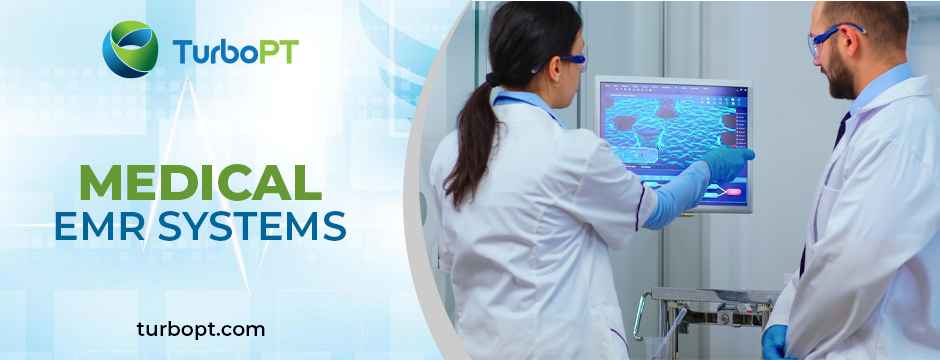With today’s busy healthcare environment, a switch to an electronic medical records (EMR) system is vital. Medical EMR System bring more efficient workflows, improved patient care, and improved regulatory compliance. However, putting these systems in place can be tricky and has issues that need careful planning and execution.
In this blog, we will discuss the typical issues healthcare providers face when putting a medical EMR system in place and share best practices for avoiding such difficulties. We will also demonstrate how emerging technologies like TurboPT’s ChatGPT-based, AI-enhanced documentation system, with AI charting functionality, are changing the life of physical therapists and other healthcare professionals.

The Promise and Potential of Medical EMR System
Electronic medical records have transformed healthcare by the use of computerized records rather than paper. This transformation enables healthcare providers to quickly access patient information, become more efficient, and enhance health outcomes. More recent EMR systems are also adopting new technologies such as artificial intelligence (AI) and natural language processing (NLP).
TurboPT incorporates ChatGPT-based technology and AI to automate documentation, generate reports, and optimize the overall clinical workflow. These technologies not only enhance productivity but also decrease errors and administrative burdens, enabling clinicians to spend more time caring for patients.
General Issues in Implementing Medical EMR System
1. Resistance to Change
One of the greatest challenges faced by healthcare providers is resistance from their staff. Transitioning from old paper-based records or outdated systems to a new EMR system can prove to be difficult. Physicians and administrative staff may resist the new technology, worried that it will disrupt their normal work or complicate their day-to-day activities.
Best Practice:
Invest in change management initiatives. Discuss the advantages of the new system early and often. Provide ample training and continuous support to enable staff to adjust. Relate success stories and statistics indicating how AI-driven solutions have enhanced productivity and patient outcomes.
2. Greater Upfront Costs and Budget Constraints
EMR system installation can be very expensive. There may be the cost of buying software, hardware upgrading, staff training, and maybe workflow disruption when switching over. Small practices may find these costs difficult to cope with.
Best Practice:
Think about doing things in phases to manage costs over time. Look for vendors that have flexible solutions based on the size and budget of your practice. Highlight the long-term benefits, like lower administrative costs, better billing accuracy, and better patient outcomes.
3. Data Security and HIPAA Compliance
In the medical system, maintaining patient data is extremely important. Installing an EMR system creates the challenge of protecting sensitive data from cyber threats. Compliance with such legislation as the Health Insurance Portability and Accountability Act (HIPAA) is mandatory, and any infraction can lead to serious legal and reputational consequences.
Best Practice:
Choose a medical EMR system that has robust security measures, such as data encryption, regular security audits, and multi-factor authentication. Ensure the vendor is complying with the newest regulations and guidelines.
4. Working with Current Systems
Most of the healthcare organizations have various computer systems for billing, scheduling, and patient communication. The integration of a new EMR system into these systems may be challenging, which may lead to workflow issues and data silos.
Best Practice:
Select an EMR solution that integrates easily with other applications. Open APIs and custom designs allow your new system to integrate easily with other digital applications. TurboPT’s EMR system is designed to integrate easily with various practice management and billing systems, so all facets of your practice flow smoothly.
5. Disruption of Workflow During Transition in Medical EMR System
With a new system, normal activities will have to be interrupted for a short time. Early learning curves will slow progress, impacting the number of patients seen and ultimately affecting the delivery of care.
Best Practice:
Develop a schedule for a time when both the new and old systems run at the same time. This will enable staff to get the new system gradually while keeping services running. Training should be done during off-peak times and the first part of the implementation.
6. Customization Issues
Each medical practice needs something unique, and no one EMR system can do it all. Customization is usually needed to make the system fit your own style of working.
Best Practice:
Work closely with the vendors to be able to modify the system according to your needs. Look for solutions that possess configurable templates and modifiable modules. TurboPT is the best EMR for physical therapy because it provides configurable templates and artificial intelligence-generated documentation that can be tailored to specialities like occupational therapy, and speech-language pathology.

Best Practices for a Successful EMR Implementation
Conduct a thorough needs assessment
Before finalizing an EMR system, perform a thorough needs assessment. Determine the problems in your current workflow and your unique needs.
Engage End-Users in the Decision Process
Engaging the end-users early in the process of choosing the system can help that the system will fulfill their daily needs. Get their feedback, organize demonstrations, and conduct a pilot test to obtain feedback from the individuals who will be utilizing the system daily.
Formulate a Clear Implementation Plan
A good plan of implementation will detail all the steps of the change. It is to include timelines, budget requirements, training programs, and contingencies for anticipated issues. It eliminates uncertainty and generates realistic expectations on the part of all concerned.
Provide Full Training and Support in Medical EMR System
It is highly critical to invest in good training programs so that all users are at ease with the new medical EMR systems. The training must be tailored based on different user roles and must comprise initial training and periodic refresher training. Think about leveraging “super-users” in your company who can help their peers. TurboPT helps do this by providing access to an easy yet robust AI-powered interface to make the transition smooth.
Monitor and Evaluate Post-Implementation
Once you have fully deployed the system, monitor its performance from time to time and make a record of user feedback. Assess parameters like accuracy of documentation, efficiency of workflow, and patient satisfaction. Make improvements and adjustments based on this record.
Focus on Security and Compliance
Keep your security protocols up to date and audit them to remain in continuous compliance with regulations. Keeping cybersecurity at the forefront will safeguard sensitive patient information. TurboPT’s adherence to HIPAA compliance and advanced encryption practices secures your practice while allowing you to leverage advanced AI capabilities.
Integration of AI and ChatGPT in Medical EMR System
One of the biggest breakthroughs in EMR implementation is the use of AI and natural language processing technologies. TurboPT billing integration shows how such innovative concepts can transform healthcare documentation. With ChatGPT, TurboPT’s system efficiently generates reports, assists in documentation, automates clinical workflows, and minimizes errors.
Benefits of AI-Based Documentation
- Efficiency and Precision: AI charting functions significantly reduce the paperwork time. With the automatic production of charts and summaries, AI minimizes the risks associated with human error.
- Improved Workflow: With regular documentation work done by AI, healthcare professionals can dedicate more time to patients. This ensures that patients receive better outcomes and the practice operates more effectively.
- Ongoing Learning: AI algorithms constantly learn from what users feed and adapt to fit new document formats and medical requirements. This ensures the system remains effective and useful over time.
TurboPT Special Offer On Medical EMR System
TurboPT‘s Electronic Medical Record program is designed specifically for physical therapists, occupational therapists, and speech-language pathologists. It automates scheduling, billing, and documentation using the latest AI and ChatGPT technology. With the AI charting feature of the system, precise and fast documentation is created that is safe and HIPAA compliant. For those who wish to modernize their practice, TurboPT provides an intelligent solution that not only resolves typical issues but also enhances patient care and the practice’s operations.
Conclusion
Implementing a medical EMR system is challenging due to resistance to change, high costs, data security issues, integration problems, workflow disruptions, and customization needs. A complete needs assessment, careful planning, user involvement, thorough training, and continuous monitoring ease the transition. Advanced technologies like AI and ChatGPT, as shown by TurboPT, streamline operations, enhance patient care, and ensure security and compliance.
Get ahead with TurboPT – the smarter way to manage medical records with AI-driven precision!
